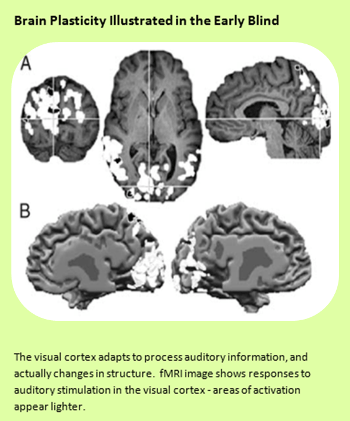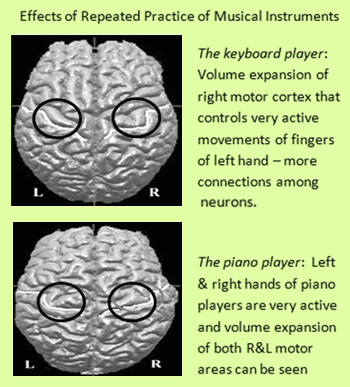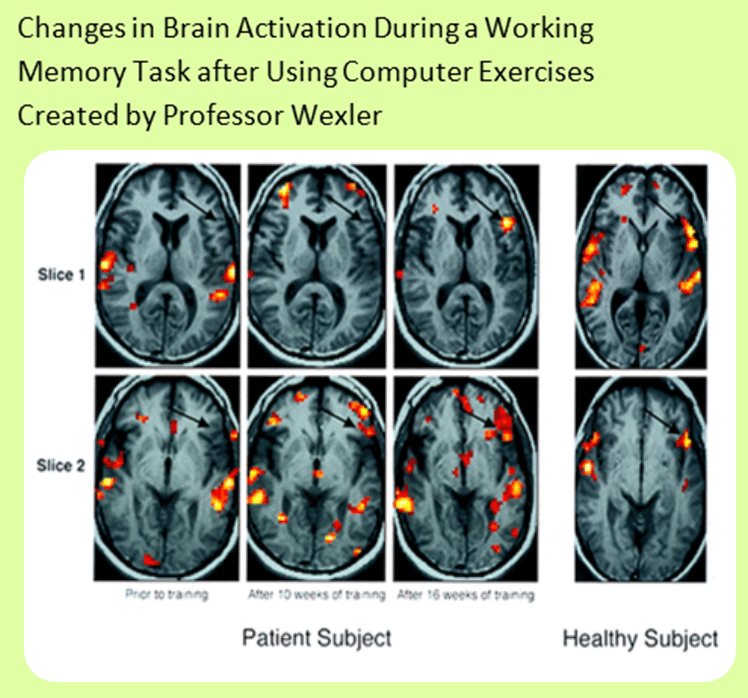Cognitive Neuroscience is Our Foundation - and Our Goal.
The brain is shaped through activity.
The study of neuroplasticity (or cognitive neuroscience) began over 50 years ago with Nobel-winning research that showed the effects of early life experiences the structure of the brain. Subsequent research has built a growing body of knowledge on this subject, and Yale Professor Bruce Wexler has been among these scientists doing pioneering work on cognitive neuroscience.
Brain images from those born blind have illustrated neuroplasticity. One early study of people born blind showed that their brains adapted to their lack of visual information by using the visual cortex to process auditory input.
The bright areas in this image show the visual cortex “lighting up” as they process auditory information. The bright spots are areas of the visual cortex that have changed their shape and function to process sound instead of sight.
Another early study showed that brains of musicians are literally shaped by their instrument. In that study, the keyboard player’s brain on the left had symmetrical shape, consistent with the symmetrical left and right brain processing requirements of the keyboard, while the string player’s brain on the right showed asymmetric development consistent with the different left and right hand neural system processing required by the violin. The different instruments actually caused differently shaped brains.


Neuroplasticity is at its most dynamic in the youngest brains.
Thanks to neuroplasticity, very young children have a remarkable ability to not only handle complex tasks like learning multiple languages in ways that older brains cannot – but to overcome challenges like injury or neglect. There is a window during early childhood when the brain is capable of extraordinary growth.
During the past 15 years, Dr. Wexler and others in the field of cognitive neuroscience have begun applying their knowledge to the goal of improving cognition in young children. In his extensive research, Dr. Wexler has developed and used computer-based programs in clinical programs to measure and exercise all 8 Core Cognitive Capacities. Two years ago, he and Dr. Jinxia Dong developed the first prototype of ACTIVATE™ and tested it with children in Beijing – children who in a matter of weeks were shown to have marked improvements in speed of information processing and working memory equivalent to a gain of 10 IQ points.
Computerized Cognitive Remediation Training (CCRT)
In the past decade medical scientists have begun to develop new treatments based on the new basic science research on neuroplasticity and Dr. Wexler has been a leader in development of plasticity based treatments for adult psychiatric disorders. He published what is probably the first paper to use plasticity-based computer-presented exercises for treating neurocognitive dysfunction in people with schizophrenia (Computerized Cognitive Remediation or CCRT). Earlier work based on behavioral learning models had attempted to ameliorate cognitive deficits through learning and practice but these lacked a foundation in neuroscience, and as a result differed in key functional features. Wexler published the first paper showing normalization of task-related regional brain activation in patients after treatment, using in that study computerized training of working memory and fMRI. There have now been over 40 published studies of CCRT in schizophrenia and several meta-analyses showing significant benefits of treatment with average effect size of 0.4.
Despite the established efficacy of CCRT in adult patients there had been extremely limited attempts to develop similar treatments for childhood disorders. This is all the more remarkable given that the greater neuroplasticity of the child’s brain increases the rationale for such interventions. There have been two preliminary and promising efforts to develop CCRT for ADHD.

Physical Activity as Cognitive Intervention
Multiply replicated studies show that non-specific physical activity increases neuroplasticity, hippocampal volumes and performance on hippocampal-related learning and memory tasks. Recent studies in children have shown that children who are physically more fit have: superior performance on multiple aspects of attention, executive control and memory; elevated event-related brain potential indices of executive function; and greater volumes of the hippocampus and dorsal striatum which are thought to be important for the cognitive operations. These are precisely the cognitive executive and attention functions compromised in ADHD.
Exercise has been evaluated for possible therapeutic benefit in depressed adults with positive results, but, as with CCRT, applications to childhood disorders has been nearly absent. The ADHD literature is limited to four studies that bear in varying degree on the issue. One correlational study found that children with ADHD who participated in more sports had fewer symptoms of depression and anxiety. A reversal design study revealed that recess reduced disturbing and inattentive behavior in both students with or without ADHD. Opportunity to engage in physical activity as reward for calmness and attention improved classroom behavior with children with ADHD. Finally, sitting on a therapy ball instead of chair improved ADHD symptoms in the classroom.
The possible value of structured physical activity in a comprehensive cognitive neuroscience treatment program for ADHD is indicated further by recent reports that boys with ADHD have more negative attitudes about sports, pay less attention to detail regarding motor movement, have more superficial knowledge about movement skills and are less skilled in movement than a control group. In addition, both boys and girls with ADHD have been shown to have greater problems with physical balance than a healthy comparison group.
